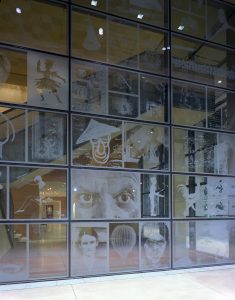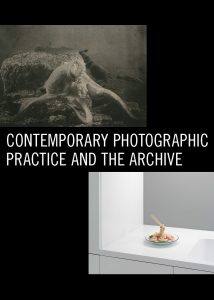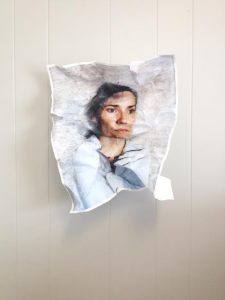
We are pleased to share our interview with Ransom Center member Susan Scafati, an Austin-based, American contemporary artist. She is a member of Lakes Were Rivers, an artist collective showcased in the Ransom Center’s 2013 exhibition Contemporary Photographic Practice and the Archive.

What first drew you to the Ransom Center?
The windows. I was going for a walk during a 36-hour visit to Austin, wrestling with whether to move here from Manhattan. Up ahead I saw, memorialized in the Ransom Center’s glass, the New York Yankees, Alfred Hitchcock, Igor Stravinsky, Eadweard Muybridge, and Eliot Elisofon’s Duchamp. I walked in and saw the first photograph—View from the Window at Le Gras by Joseph Nicéphore Niépce. The building was silent and no one was around. Having these sorts of private experiences with iconic works in spaces, where art has the room just to be, changed my perception of art that I’d been looking at for years in books, on screens, and in crowded venues, and drew me to the area.

How did it feel to participate in the Contemporary Photographic Practice and the Archive exhibition at the Ransom Center in 2013? What were some highlights of that experience?
It was an honor to be an exhibiting artist with my art collective Lakes Were Rivers in Contemporary Photographic Practice and the Archive—the first time the Ransom Center invited artists to organize an exhibit.
One particularly memorable experience I had during the making of the project was a research meeting with Senior Research Curator Roy Flukinger in 2012. Roy was in the midst of sorting through the Ransom Center’s newly acquired Arnold Newman archive and welcomed me in for what ended up being a few hours as he sorted through letters, contact sheets, and objects, sharing vivid personal memories of his Newman encounters as he went. That experience—seeing what goes into the extensive archive process first-hand from the time of initial receipt and its significance in preserving history—made an impression on me.
What made you decide to become a member?
I started making trips to the Ransom Center as a sort of refuge to sink into the why and how of the creative process. I was in awe of the extent that the private, public, and creative lives of my art heroes were preserved, and the expertise on hand to navigate the vast systemization of information housed in the archives. I’m selective with the institutions I support, and the Harry Ransom Center is a priority to me.

How has your involvement with the Ransom Center inspired or affected your art?
My body-of-work titled Shelly that I created for the Contemporary Photographic Practice and the Archive exhibition was directly influenced by the Ransom Center. One day I was in the Norman Mailer archives and came across an old candid snapshot of him in swim trunks and a snorkel mask. It got my imagination going with questions. I became enthralled by how one’s personal artifacts became part of a larger web of meaning, within the context of their archive. Shelly draws a very physical connection to the archives. I deliberately emulated material examples that I came across in my research where the hand of the artist is present—for example editing marks on Arnold Newman’s contact sheets and the torn, crumpled remains of thousands of artists’ drafts-in-progress. I wanted to draw parallels and blur lines between in-progress versus finalized gestures. This led me to create a 6” x 36’ x 48” installation consisting of over 300 artifacts from the making of my project—marked contact sheet cutouts, and objects with project or autobiographical relevance including a photo lab bag, violin strings, and nylons. This installation along with other Shelly works are all together my abstractions on the act of archiving itself.
What has being a member meant to you?
Being a member has enriched my life as an artist and culture lover. It’s a hometown retreat.
